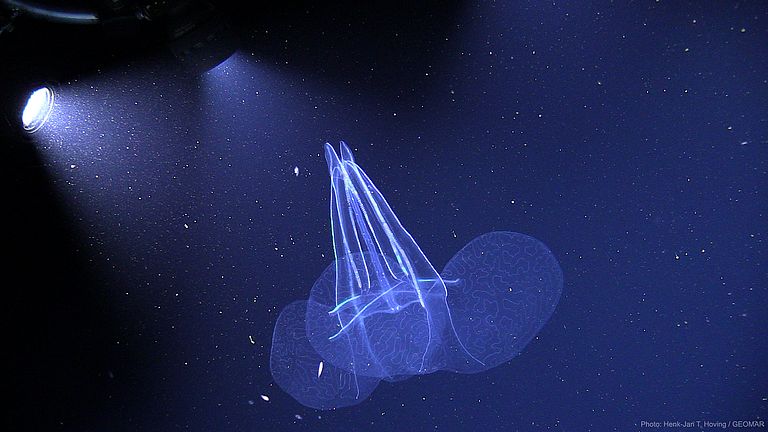Image of the month: June 2019
Diving with JAGO
Our image of the month shows the submersible JAGO in the sapphire blue waters of the tropical Atlantic Ocean. There, off the Cape Verdean coast, it accompanied the POS520 research cruise in February 2018. Dr. Henk-Jan T. Hoving (GEOMAR), sitting behind the large acrylic window, led the voyage. JAGO has been in operation since 1989 and is the only manned research submersible in Germany. With its help, samples can be taken from both near the seabed and in the water column. Above all, JAGO enables scientists to study their research targets very closely and in their natural habitat. This not only advances our knowledge of animal behavior in the ocean, for example, but is also a unique experience. The team of POS520 used the submersible very often for research that they mainly conducted in the pelagic deep sea, i.e. in the water column of the open ocean, off Cape Verde.
The ecosystems of the pelagic zone have barely been investigated to date, because the environment is large and deep-sea research is challenging. The Cape Verde region, with its deep sea very close to the shore, is an exception. The inhabitants of the deep may be very mobile, particularly small or with an extremely delicate body structure. For this reason, the JAGO team had developed two new sampling systems specifically for this application: a suction pump and a collecting cylinder, with which the organisms are collected undamaged out of the water. This is particularly suitable for the collection of gelatinous zooplankton. The team of POS520 was able to make one of the first detailed underwater observations and recordings of the comb jelly Kiyohimea usagi in the Atlantic Ocean. Until then, it was assumed that the animal lived exclusively in the Pacific. Thanks to the cautious collection method, other species could also be investigated more closely, such as the transparent flea crayfish of the species Leptocotis, which completely consumes the interior of its hosts.
Water samples taken with a Rosette Water Sampler from different depths and at different times of the day were filtered to obtain eDNA (environmental DNA). eDNA are traces of species (scales, cells or other organic material) in the water and it allows for the genetic identification of species that were at some point present within a sampled volume of water without the need to catch or observe the animal. The scientists used nets to sample organisms from different depths. The different methods used during POS520 complemented each other nicely. Surveys with JAGO help the scientists to understand via visual census the communities in the deep pelagic zone, many of which cannot be captured by nets due to their fragile nature. Data from eDNA analyses can be compared with JAGO's observations and net catches. Each dive with JAGO helps researchers to better understand the biodiversity and ecology of unexplored deep-sea habitats.
Further information:
http://www.oceanblogs.org/capeverde/
https://www.geomar.de/zentrum/einrichtungen/tlz/jago/uebersicht/
![[Translate to English:] Das bemannte Tauchboot JAGO im Einsatz zur Erforschung der biologischen Vielfalt und Ökologie der Tiefsee um Kap Verde während der Expedition POS520. Foto: Uli Kunz / Submaris The manned submersible JAGO exploring the biodiversity and ecology of the deep sea around Cape Verde during the POS520 expedition. Photo: Uli Kunz / Submaris](/fileadmin/_processed_/5/0/csm_06_2019_ba923ad0fc.jpg)



